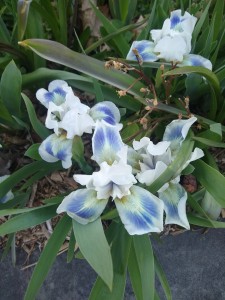 Long ago I heard an old recording of Marlene Dietrich, early twentieth century German chanteuse and style icon, singing one of her signature ballads. The words go, “Falling in love again, in love again. Falling in love again, can’t help it.”
Long ago I heard an old recording of Marlene Dietrich, early twentieth century German chanteuse and style icon, singing one of her signature ballads. The words go, “Falling in love again, in love again. Falling in love again, can’t help it.”
I know the feeling. On my recent vacation a dwarf bearded iris caught my eye. The flowers were yellow, growing more pale towards the center of each petal. But the loveliest and most surprising thing about each bloom was its beard—the collection of fuzzy hairs on the falls or downward facing petals–which were bright blue. I was smitten—so smitten that I grabbed one from the plant pallet and rushed to the checkout. I wasn’t taking a chance on some random plant-browser snatching my new love object while I was distracted elsewhere.
My new dwarf iris acquisition joins another dwarf that I installed in the garden several years ago. It stands about six inches tall and its flowers are white marked with purple. The beards are pale lavender. It has flourished in a sunny spot on my front “hell strip” and has increased from one plant to a nice clump. This year I will probably divide it and spread its offspring to other parts of the garden.
In general, iris, whether they are taller or smaller, have been in cultivation for millennia. The standard dwarf category, which is recognized by the American Iris Society, is home to plants “ranging in height from 20 cm (8 inches) to 41 cm (16 inches).” Displaying many of the same colors and color patterns as larger bearded iris, the smaller specimens bloom weeks ahead of their more statuesque relations. This is especially useful in the spring garden, where they appear after the early and mid-season daffodils, strutting their stuff alongside the tulips and later narcissus.
Plant breeders and specialty plant societies are very protective of their work and classification systems, which has often resulted in squabbles, feuds, and perennial issues worthy of soap operas. Sometimes, in fact, the smaller the flower, the bigger the drama. That has been the case with standard dwarf irises since the category was first developed in the mid-twentieth century.
An iris breeder named Robert Schreiner, whose namesake iris nursery still leads the industry, became instrumental in developing the small iris when he sought out seeds of the little-known Iris pumilla, a diminutive species native to Austria, Eastern Europe and the Balkans. The pumilla iris offered more color variation than small species already grown in North America, and Schreiner aimed to use the pumillas to expand the color range in the smaller plants. Obtaining those seeds from sources overseas, Schreiner began breeding efforts that culminated in further hybridizing work in the 1940’s. Eventually, breeders created enough varieties of what would be christened standard dwarf iris to cross breed those varieties with each other, a practice that continues to this day.
Iris aficionados were of divided opinion about how to classify the charming little plants, finally settling on the current American Iris Society size-based system in use today, which includes the following categories: miniature dwarf bearded; standard dwarf bearded; intermediate bearded; border bearded; miniature tall bearded and tall bearded iris.
What does all of that mean to the average gardener who just wants beautiful iris? Almost nothing. Most of us pick the colors and sizes that will fit into our gardens or container planting schemes. The smaller iris, like my existing and new dwarf specimens, have the advantage of earlier seasons of bloom, providing a nice segue to the dramatic show provided by the voluptuous tall varieties. They also fill the bill for modern small-space cultivation, fitting neatly into rock gardens, containers, or diminutive beds and borders.
For those of us bedeviled by critters of various sorts, including voracious deer, it helps to know that little iris, like their larger relatives, are not generally attractive to four-legged browsers. Iris are shallow-rooted, with the rhizomes lying very close to the soil surface, so you don’t have to dig the big holes necessary for other showy plants like roses and peonies. The plants like sunny sites and well-drained soil, but will mostly get along without much help.
The dreaded enemy of all rhizomatous iris is the iris borer, an insidious creature that destroys the rhizomes by boring into them. If your iris are not thriving, check the rhizomes. If they are soft or spongy, they may be prey to iris borer, and you can usually find some of the creatures hard at work burrowing into the roots. If that is the case, dig up and destroy the affected rhizomes.
Barring borers, the only thing you really have to do to maintain iris is to divide the clumps every few years. Crowded iris sprout in a circular formation, with the oldest and least productive part of the clump in the center. Dig up the clump, discard the central portion and divide the rest, making sure that each rhizomatous piece is firm and has sprouting leaves attached. Replant one or two divisions in the original location as well as additional new sites, or give pieces to lucky gardening friends. That is how I acquired my first tall bearded iris and they are still blooming years later.
At this time of year, local garden centers are full of tall bearded iris, but may be short on the standard dwarf varieties. If you crave these little bloomers try, Schreiner’s Iris Gardens, 3625 Quinaby Road NE, Salem OR 97303; (800) 525-2367; www.schreinersgardens.com.
